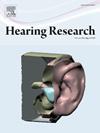A machine-learning-based approach to predict early hallmarks of progressive hearing loss
IF 2.5
2区 医学
Q1 AUDIOLOGY & SPEECH-LANGUAGE PATHOLOGY
引用次数: 0
Abstract
Machine learning (ML) techniques are increasingly being used to improve disease diagnosis and treatment. However, the application of these computational approaches to the early diagnosis of age-related hearing loss (ARHL), the most common sensory deficit in adults, remains underexplored. Here, we demonstrate the potential of ML for identifying early signs of ARHL in adult mice. We used auditory brainstem responses (ABRs), which are non-invasive electrophysiological recordings that can be performed in both mice and humans, as a readout of hearing function. We recorded ABRs from C57BL/6N mice (6N), which develop early-onset ARHL due to a hypomorphic allele of Cadherin23 (Cdh23ahl), and from co-isogenic C57BL/6NTacCdh23+ mice (6N-Repaired), which do not harbour the Cdh23ahl allele and maintain good hearing until later in life. We evaluated several ML classifiers across different metrics for their ability to distinguish between the two mouse strains based on ABRs. Remarkably, the models accurately identified mice carrying the Cdh23ahl allele even in the absence of obvious signs of hearing loss at 1 month of age, surpassing the classification accuracy of human experts. Feature importance analysis using Shapley values indicated that subtle differences in ABR wave 1 were critical for distinguishing between the two genotypes. This superior performance underscores the potential of ML approaches in detecting subtle phenotypic differences that may elude manual classification. Additionally, we successfully trained regression models capable of predicting ARHL progression rate at older ages from ABRs recorded in younger mice. We propose that ML approaches are suitable for the early diagnosis of ARHL and could potentially improve the success of future treatments in humans by predicting the progression of hearing dysfunction.
一种基于机器学习的方法来预测进行性听力损失的早期特征
机器学习(ML)技术越来越多地被用于改善疾病的诊断和治疗。然而,将这些计算方法应用于年龄相关性听力损失(ARHL)的早期诊断,这是成年人最常见的感觉缺陷,仍未得到充分探索。在这里,我们展示了ML识别成年小鼠ARHL早期症状的潜力。我们使用听觉脑干反应(ABRs)作为听觉功能的读数,这是一种非侵入性的电生理记录,可以在小鼠和人类中进行。我们记录了C57BL/6N小鼠(6N)和C57BL/6NTacCdh23+小鼠(6N- repair)的abr,前者由于Cadherin23的次形等位基因(Cdh23ahl)而发生早发性ARHL,后者不携带Cdh23ahl等位基因,直到晚年才保持良好的听力。我们通过不同的指标评估了几种ML分类器基于abr区分两种小鼠品系的能力。值得注意的是,即使在1月龄没有明显听力损失迹象的情况下,这些模型也能准确地识别出携带Cdh23ahl等位基因的小鼠,超过了人类专家的分类精度。使用Shapley值进行特征重要性分析表明,ABR波1的细微差异是区分两种基因型的关键。这种优越的性能强调了机器学习方法在检测可能无法进行人工分类的细微表型差异方面的潜力。此外,我们成功地训练了能够从年轻小鼠记录的abr中预测老年ARHL进展率的回归模型。我们建议ML方法适用于ARHL的早期诊断,并有可能通过预测听力功能障碍的进展来提高人类未来治疗的成功率。
本文章由计算机程序翻译,如有差异,请以英文原文为准。
求助全文
约1分钟内获得全文
求助全文
来源期刊

Hearing Research
医学-耳鼻喉科学
CiteScore
5.30
自引率
14.30%
发文量
163
审稿时长
75 days
期刊介绍:
The aim of the journal is to provide a forum for papers concerned with basic peripheral and central auditory mechanisms. Emphasis is on experimental and clinical studies, but theoretical and methodological papers will also be considered. The journal publishes original research papers, review and mini- review articles, rapid communications, method/protocol and perspective articles.
Papers submitted should deal with auditory anatomy, physiology, psychophysics, imaging, modeling and behavioural studies in animals and humans, as well as hearing aids and cochlear implants. Papers dealing with the vestibular system are also considered for publication. Papers on comparative aspects of hearing and on effects of drugs and environmental contaminants on hearing function will also be considered. Clinical papers will be accepted when they contribute to the understanding of normal and pathological hearing functions.
 求助内容:
求助内容: 应助结果提醒方式:
应助结果提醒方式:


